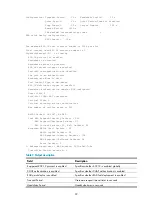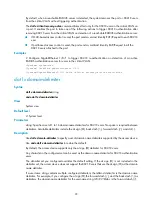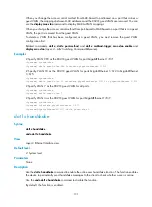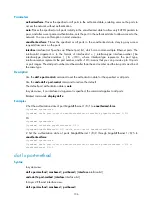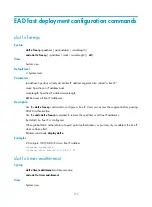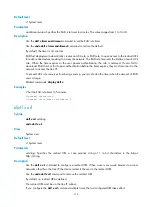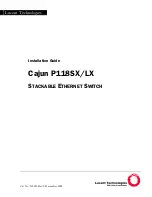
100
The
cut connection user-name
user-name
and
display connection user-name
user-name
commands are
not available for 802.1X users that use back slash (\), forward slash (/), or dot (.) as the domain name
delimiter. For more information about the two commands, see
Security Command Reference
.
Examples
# Specify the characters
@
,
/
, and
\
as domain name delimiters.
<Sysname> system-view
[Sysname] dot1x domain-delimiter @\/
dot1x guest-vlan
Syntax
In system view:
dot1x guest-vlan
guest-vlan-id
[
interface
interface-list
]
undo dot1x guest-vlan
[
interface
interface-list
]
In Layer 2 Ethernet interface view:
dot1x guest-vlan
guest-vlan-id
undo dot1x guest-vlan
View
System view, Layer 2 Ethernet interface view
Default level
2: System level
Parameters
guest-vlan-id
: Specifies the ID of the VLAN to be specified as the 802.1X guest VLAN, in the range 1 to
4094. It must already exist. Ensure that the VLAN has been created.
interface
interface-list
: Specifies a port list. The
interface-list
argument is in the format of
interface-list
=
{
interface-type
interface-number
[
to
interface-type
interface-number
] } & <1-10>, where
interface-type
represents the port type,
interface-number
represents the port number, and & <1-10> means that you can
provide up to 10 ports or port ranges. The start port number must be smaller than the end number and
the two ports must be of the same type. If no interface is specified, you configure an 802.1X guest VLAN
for all Layer 2 Ethernet ports.
Description
Use the
dot1x guest-vlan
command to configure an 802.1X guest VLAN for the specified or all ports.
Use the
undo dot1x guest-vlan
command to remove the 802.1X guest VLAN on the specified or all ports.
By default, no 802.1X guest VLAN is configured on a port.
You must enable 802.1X for an 802.1X guest VLAN to take effect.
To have the 802.1X guest VLAN take effect, complete the following tasks:
•
Enable 802.1X both globally and on the interface.
•
If the port performs port-based access control, enable the 802.1X multicast trigger function.
•
If the port performs MAC-based access control, configure the MAC-based VLAN function on the
port.







